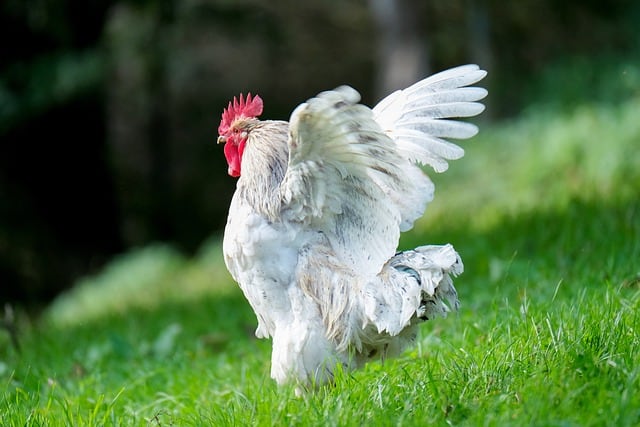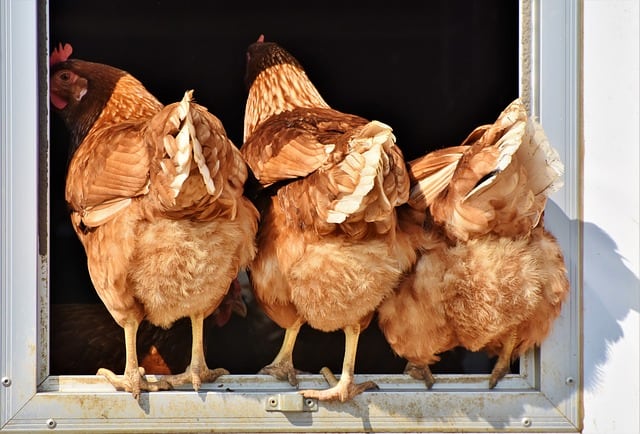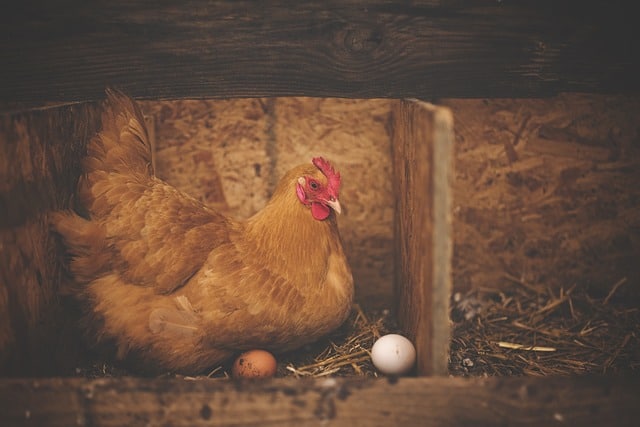So many people have wondered why chickens have wings yet aren’t capable of flying for long distances like other birds in the wild or a few domesticated ones. Even more interesting is that the wings are large, strong, and well developed.
This post will answer this question sufficiently enough to settle the matter for the curious. If you still have questions by the end, then it would be safe to enjoy the elegance of these creatures.
Contents
Functions Of Wings in Chickens
Interestingly, many people believe that chickens have wings for no purpose at all. They consider them rudimentary or simply vestigial body structures. I once did until I looked at the birds closely. Here are the functions of wings in chicken:
1. Balance and Stability
Chickens use their wings to help maintain balance and stability while walking, running, and navigating various terrains. The wings act as counterbalances, enabling them to make quick turns and changes in direction.
We all know that chickens are extremely active creatures who constantly explore their environment because of their natural curiosity and the need to find food. Indeed, their wings may not be helpful in long-distance flight; however, they provide them with much-needed lift while attempting to climb high objects such as walls, trees, and rooftops.
2. Communication and Display
Look in the wild and appreciate how birds in the jungle communicate with each other. The wings are an integral part of that communication. They also display an array of moves for various reasons, especially between couples.
Chickens use their wings for communication and visual displays, especially during courtship rituals or to assert dominance. They may flap their wings, raise them, or extend them to communicate with other chickens and establish their social status.
3. Protection and Defense
Chickens face threats from both land and aerial predators. Eagles, hawks, and other birds of prey can attack chicks while they are being cared for by their mother. Such predators primarily target the vulnerable chicks, but larger eagles may even go after fully grown mature chickens. Similarly, land predators pose a danger to chickens as well.
When threatened or alarmed, chickens can quickly spread their wings as a defensive posture. This behavior can make them appear larger and more intimidating to potential predators or rival chickens.
Also read: Best Chicken Fence Reviews & Buying Guide
4. Thermoregulation
Wings play a vital role in helping birds achieve thermoregulation in many ways including feather insulation, wing posture, elaborate blood circulation in the wings, and wing shivering.
Like other birds, chickens have feathers on their wings that provide insulation. Feathers trap air close to the body, creating a layer of insulation that helps retain body heat in cold temperatures.
Regarding posture, chickens can adjust the position of their wings to regulate heat exchange. They can also hold their wings closer to their body to conserve heat or spread them away from their body to increase heat dissipation.
Chicken wings have rich and elaborate blood circulation. By regulating blood flow to their wings, chickens can control the heat transfer between their body core and the wing surface. When they need to cool down, they can increase blood flow to their wings to facilitate heat loss through the skin.
Similar to other birds, chickens may shiver their wings rapidly as a thermoregulatory mechanism. Wing-shivering generates heat through muscular activity, helping chickens raise their body temperature during colder periods.
5. Protection from Elements
The wings of chickens are covered with feathers that provide insulation. Feathers trap air close to the body, creating a layer of insulation that helps protect chickens from both cold and hot weather conditions. In cold weather, the feathers on the wings help retain body heat, while in hot weather, they provide shade and prevent direct exposure to sunlight.
Chickens can partially or fully spread their wings to create a protective canopy. They can shield themselves from rain, snow, or excessive sunlight by doing so. This behavior allows them to find temporary shelter and maintain a more comfortable body temperature.
These birds can also use their wings to cool down in hot weather. They may hold their wings away from their body to increase airflow around their body, promoting heat dissipation through evaporation and providing some relief from high temperatures.
Finally, after exposure to moisture, such as rain or bathing, chickens will often stretch out their wings and flap them vigorously. This wing-drying behavior helps to remove excess moisture and aids in maintaining the insulating properties of their feathers.
Also read: Best Chicken Coop
To Assert Dominance
Chickens, particularly roosters (male chickens), use their wings in various ways to assert dominance within their social hierarchy. Here are a few ways in which chickens use their wings for dominance:
- Wing Display: Roosters may use their wings to display dominance and establish their authority. They can spread their wings wide, making themselves appear larger and more intimidating to rivals. This display, often accompanied by fluffing up their feathers, is known as “wing flapping” or “wing drooping.” It serves as a visual signal to other chickens, indicating their dominance and willingness to defend their territory.
- Wing-Beating: In confrontations with other chickens, roosters may engage in aggressive behavior called “wing-beating.” This involves rapidly flapping their wings against their sides while approaching or attacking another chicken. Wing-beating is meant to intimidate rivals and establish dominance through physical displays.
- Wing-Lowering: Another behavior seen in dominant roosters is wing-lowering. When approaching a subordinate chicken or challenging a rival, the dominant rooster may lower one wing, partially spreading it on the ground. This gesture is a clear visual signal of dominance and can be accompanied by other aggressive behaviors like puffing up feathers or vocalization.
- Wing-Brushing: Roosters may use a behavior called “wing-brushing” to assert dominance over hens. They extend their wings partially and sweep them across the ground while strutting toward the hens. This display is intended to capture the attention of the hens and signal their status as the dominant male.
Why Can’t Chicken Fly?
With all the information we have learned so far, you might wonder why chickens can’t fly, yet they have wings just like their wild counterparts. We have put a piece to explain how chickens lost their flying ability.
As a domesticated species, Chickens have undergone changes through selective breeding that have resulted in their inability to fly or fly effectively. While their ancestors, such as the Red Junglefowl, could fly, domestic chickens have lost this ability due to several reasons:
Body size and weight:
Selective breeding has led to the development of larger and heavier chicken breeds. The increased body size and weight have made it difficult for chickens to generate enough lift to become airborne.
Muscular changes:
Domestic chickens have experienced changes in their musculature, particularly in the muscles responsible for flight. These changes have reduced the strength and development of flight muscles, making it challenging for chickens to achieve sustained flight.
Wing structure:
The wings of chickens have also changed over time. They are proportionally shorter and have a different shape than their flying ancestors’ wings. These alterations affect the aerodynamics and lift generation required for sustained flight.
Domestication and human intervention:
Through selective breeding, humans have focused on traits such as meat production, egg-laying capacity, and other desired characteristics rather than maintaining flight ability. This intentional breeding for specific traits has resulted in losing flight capability in domestic chicken populations.
It’s important to note that not all chicken breeds are flightless, and some chicken hybrids or smaller breeds may retain limited flight capabilities. However, most domesticated chicken breeds commonly found today have been selectively bred for meat or egg production, resulting in reduced flight ability or complete flightlessness.
Also read: Best Chicken Egg Incubator
Are There Chickens Better at Flying Than Others?
Among domesticated chicken breeds, the vast majority are not well-suited for flying due to selective breeding focused on other traits such as meat production or egg-laying capacity. As a result, most commonly found chicken breeds are flightless or have limited flight capabilities.
However, it’s worth noting that there are some chicken breeds or individual birds within breeds that may retain a certain level of flight ability. These are often lighter and more agile breeds that have not been bred specifically for meat production. Examples include certain bantam breeds or gamefowl breeds, which may possess better flight capabilities compared to larger, heavier breeds.
In general, though, flight is not a primary characteristic or natural behavior for most domestic chicken breeds. The reduction in flight ability results from selective breeding over generations, which has led to changes in body size, weight, wing structure, and muscle development.
While some chickens may exhibit short bursts of flight or be capable of limited flying over short distances, their flight abilities are usually far more limited than their wild counterparts or bird species that have not undergone extensive domestication.
Conclusion
We hope the information you have learned above has sufficiently answered your question of why chickens have wings.
While they may be for flying, this part of the chicken body plays a vital function, and their absence of disease could limit the chances that the domesticated bird will survive to adulthood. Without balance and stability, a chicken will not walk or avoid obstacles. Also, chickens lacking wings cannot protect themselves from elements and predators.





